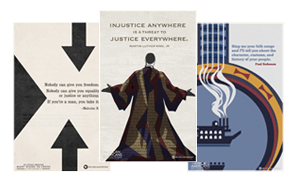George Washington’s Runaway Slave, Harry
Of our first five presidents, four owned slaves. Thomas Jefferson’s slave-owning legacy has been covered in the news lately; however, the biggest slave owner among the four men was the father of our country, George Washington.
Washington and his wife Martha together owned about 200 slaves at the beginning of the Revolution, but at the end of his life the couple owned 317 slaves together. And at least two of these became quite famous, for very different reasons.
William “Billy” Lee, Washington’s personal servant, was the only slave whom Washington freed outright upon the former president’s death (all the others were to be freed upon his wife’s death, though she freed them 12 months after Washington passed). He is depicted looking adoringly at his master in John Trumbull’s famous painting of the president of 1780 (pictured above), standing faithfully by his side.
At the other extreme of attitudes toward the master of Mount Vernon, however, stands another slave. He was a fascinating rebel named Harry, whose life and times have been painstakingly recreated by the historian Cassandra Pybus. And Harry’s dogged determination to be free suggests that not all of the slaves found Washington to be the benevolent master whom historians have depicted.
Harry’s first escape from Mount Vernon occurred on July 29, 1771. Washington was not amused: He “paid one pound and sixteen shillings to advertise for the recovery of his property,” Pybus tells us in the book The Human Tradition in the Black Atlantic, 1500-2000. Harry was returned a few weeks later. Undaunted and determined to be free, Harry awaited a second chance.
That would come in the early years of the Revolution, on Nov. 14, 1775, when John Murray, the fourth Earl of Dunmore and the Royal Governor of the Colony of Virginia, issued an astonishing proclamation that freed any slaves who were willing to bear arms for the British Crown. Slaves ran away in droves. Dunmore himself reported that by the end of November, “two and three hundred already [have] come in and these I form into a Corps as fast as they come.”
The historian Jill Lepore, in a New Yorker review of Simon Schama’s fascinating book about the black Loyalists, Rough Crossings, estimates, incredibly, that “between eighty and a hundred thousand (nearly one in five [black slaves]) left their homes … betting on British victory.” But Pybus insists that a more realistic figure is between 20,000 and 30,000 who defected to the British side during the war — still a stunningly high figure, since historians estimate that about 5,000 black men served the Patriot cause in the Continental Army (including my own fourth-great grandfather, John Redman). Many died of disease or in battle or were simply returned to their masters. Historians estimate about 15,000 former slaves left the United States with the evacuating British.
While Washington’s plantation manager, Lund Washington, professed to having “not the least dread” that the general’s slaves would join this mad melee and flee their supposedly benevolent master, Washington knew better, privately admitting that “the momentum of slave defections would be ‘like a snow ball in rolling.’ ”
The general was right: Harry, seizing his opportunity and always fleet of foot, ran away in 1776, along with three white indentured servants. And they were not the last to do so: As late as April 1781, 18 slaves fled the plantation. Though the war was raging, Washington was determined to retrieve his property, hiring a slave catcher who managed to return seven, but not Harry.
Harry served nobly in Dunmore’s all-black Loyalist regiment called “the Black Pioneers.” He rose to the rank of corporal, participating in the invasion of South Carolina and the siege of Charleston, and serving in charge of “a company of Black Pioneers attached to the Royal Artillery Department in Charleston in 1781.”
At war’s end, with the British defeat, Harry was part of a black community consisting of some 4,000 people who found safe haven in the British zone in New York, nervously awaiting their fate, since the victorious Americans insisted in the peace treaty that all runaway slaves be returned. As Pybus reports, Washington, despite the victory over British tyranny, remained ever-determined to regain his escaped property. He instructed his army contractor, Daniel Parker, to do his best to find his slaves: “If by chance you should come at the knowledge of any of them, I will be much obliged by your securing them so I may obtain them again.”
But the British kept their word: Onboard a ship named L’Abondance in July 1783, along with 405 other black men, women and children, a 43-year-old Harry set sail with his wife, Jenny, for Nova Scotia and freedom, in a settlement they named “Birchtown.”
Nova Scotia, it turned out, was not to be the promised land that Harry and his compatriots hoped it would be. The weather was horrible, rocky land allocated to the black settlers was difficult to cultivate and white settlers often underpaid black workers. For some, it was another nightmare — better than slavery, but just barely. After protesting to the British government in 1791, half of the black settlers were relocated to Sierra Leone in Africa, lured by the promise of “20 acres for every man, ten for every woman and five for every child.”
If Canada was not the promised land, neither, unfortunately, was Sierra Leone. Although Harry and his wife managed to start their own farm, the settlers suffered unduly from a tax imposed by the Sierra Leone Company called a “quit rent,” which created a system of perpetual indebtedness that in effect was a British forerunner of sharecropping. When Harry — a revolutionary to the end — protested, he and his supposed collaborators were arrested, charged with “open and unprovoked rebellion” and tried by a military tribunal. Harry, now aged 60, along with 23 of his fellow rebels, was banished from his community “across the Sierra Leone River to the Bullom Shore” for life. And there, the historical record ends.
Fifty of the 100 Amazing Facts will be published on The African Americans: Many Rivers to Cross website. Read all 100 Facts on The Root.
Find educational resources related to this program - and access to thousands of curriculum-targeted digital resources for the classroom at PBS LearningMedia.
Visit PBS Learning Media






